Linux Statistics 2024 By Market Share, Usage Data, Number Of Users and Facts
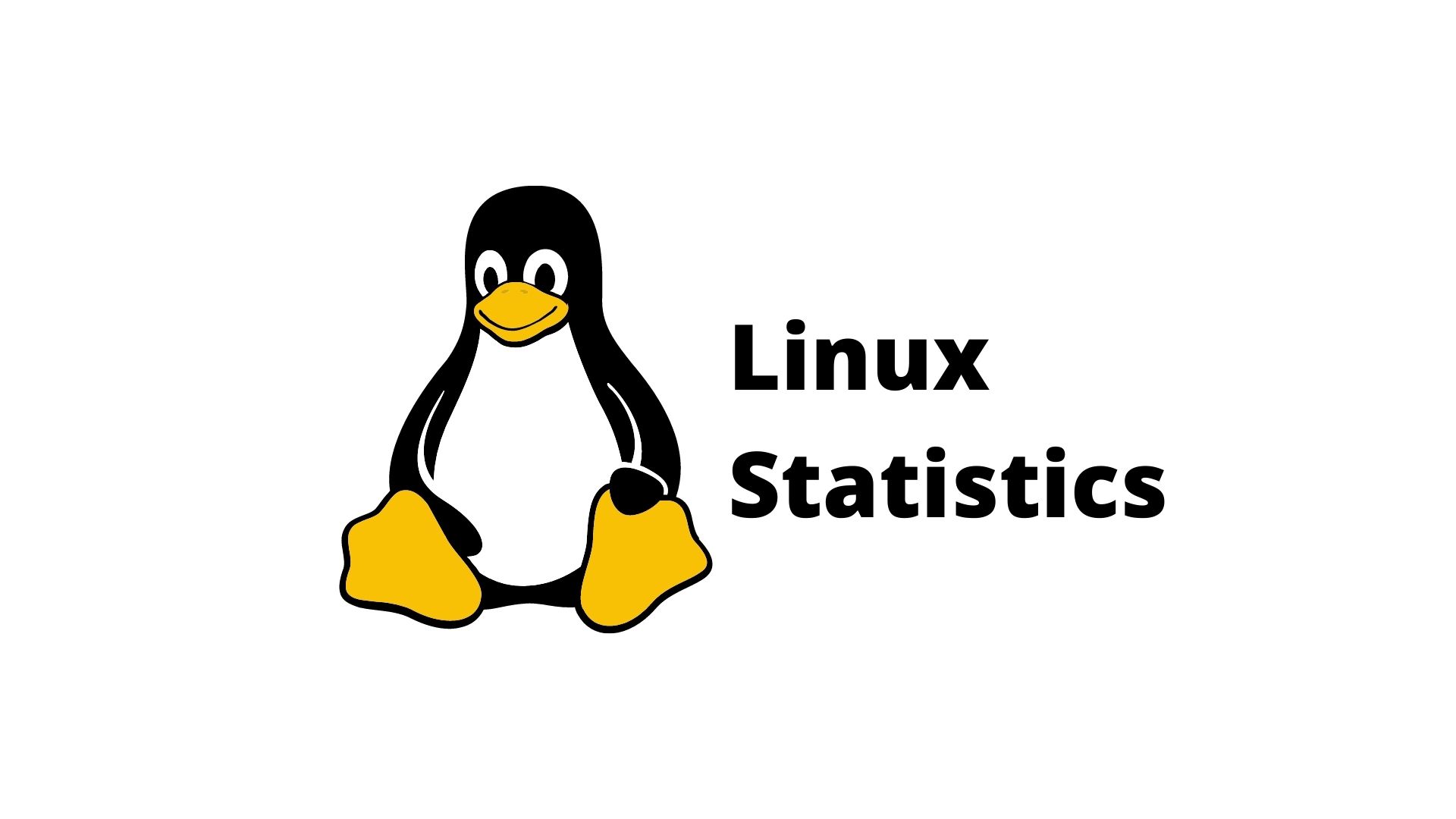
Page Contents
Linux Statistics: We ask people to tell us what the limits of Linux are when it comes to efficiency. Then we see that Linux is not rated as high, but its few features outweigh any other popular operating system. This is why it is so dominant in this area. Mobile accounts for nearly half of all internet traffic globally. Although it uses open-source code, many of its features remain a mystery. Let’s look at Linux’s Statistics and continue our research.
Editor’s Choice
- 47% of Professional developers prefer Linux operating systems. (Statista)
- Its capabilities account for 39.2% of websites whose operating systems are known. (W3Techs)
- 85% of smartphones are powered by Linux (Hayden James).
- Its marketing share is 2.09 %. is, without doubt, third in Statista's top ten most-used desktop operating systems.
- By 2027, the global Linux market will reach $15.64 trillion. (Fortune Business Insights).
- Linux is the operating system of all the world's fastest supercomputers. (Blackdown)
- 96.3% of The top 1,000,000 web servers use Linux. (ZDNet)
- Active Linus distros are still available today(Tecmint).
- In 2022, Linux claimed a 34% market share in the container orchestration market, reflecting its versatility.
- Linux holds approximately 3% of the desktop operating system market share according to StatCounter.
- The Linux kernel, the core of the operating system, consists of more than 80 million lines of code, showcasing its complexity and robustness.
- Linux is the preferred choice for web hosting, powering more than 95% of the top 1 million websites.
- It enjoys ubiquity in the supercomputing realm, running on 100% of the world's supercomputers.
- In 2022, Linux server revenue reached an impressive USD 13.4 billion, indicating its economic significance.
- Linux offers a diverse landscape with over 500 different distributions catering to various user needs.
- The cloud computing landscape heavily relies on Linux, with over 90% of public cloud workloads being Linux-based.
- Despite its desktop market share, Linux accounts for approximately 36.7% of all operating systems on desktop computers.
- Android, built on the Linux kernel, dominates the global smartphone market with a staggering 70% market share.
- The Linux server market is expected to continue growing with an annual growth rate of 8.6%.
- Linux's prowess extends to supercomputing, as over 92% of the world's top 500 fastest supercomputers run on Linux.
- The global community of active Linux users exceeds a remarkable 100 million.
- Android, a Linux-based operating system, sees over 1.5 billion smartphone shipments annually.
- The embedded Linux market boasts an estimated size of USD 5.3 billion, signifying its role in various industries.
- Linux is the platform of choice for 68% of IoT devices and systems, indicating its reliability.
- With over 25,000 contributors, the Linux kernel enjoys robust development and continuous improvement.
- The enterprise Linux market is projected to reach USB 14.4 billion by 2025, driven by business adoption.
- Linux's reputation for security is strong, being considered 10 times more secure than some other operating systems.
- Linux plays a critical role in the world's stock exchanges, powering more than 75% of them.
- Its open-source nature leads to an average of 10,000 lines of code added daily, demonstrating its active development.
- Linux remains the primary operating system for 70% of web servers globally.
- Job postings related to Linux have surged by 31% in the last year, highlighting the high demand for Linux professionals.
You May Also Like To Read
- DDoS Statistics
- Virtual Reality Statistics
- Oracle Statistics
- Augmented Reality Statistics
- Machine Learning Statistics
- Most Popular Programming Languages Statistics
- Microsoft Teams Statistics
Key Linux Statistics
- Market Share and Usage: Linux holds a 2.09% share of the desktop operating system market, making it the third most popular after Windows and macOS. In the server domain, Linux accounted for 13.6% globally in 2019, showcasing significant usage in infrastructure.
- Market Size: The global Linux market is expected to reach $15.64 billion by 2027, with a compound annual growth rate (CAGR) of 19.2%. This growth is driven by the increasing number of servers, rising internet penetration rates, and the expansion of data centers.
- Cloud Infrastructure: Linux dominates cloud computing, powering over 90% of cloud infrastructure. It is the backbone for major public cloud providers like AWS, Google Cloud Platform, and Microsoft Azure due to its scalability, security, and cost-effectiveness.
- Mobile Devices: Linux significantly impacts the mobile device market, with Android, the most widely used mobile operating system, based on the Linux kernel. Android's open-source nature allows for extensive customization.
- Security: Known for its robust security features, Linux is a popular choice for organizations and individuals concerned about data protection. Its kernel includes various security features like access control lists (ACLs), mandatory access control (MAC), and secure computing mode (seccomp).
- IoT and Smart Devices: In the Internet of Things (IoT) ecosystem, Linux powers a wide range of devices, from smart home devices to industrial IoT applications, thanks to its stability and flexibility.
- Developer Preference: Linux is preferred by 47% of professional developers, highlighting its flexibility and the availability of compilers or interpreters not found in Windows.
- Web Servers: Linux powers 96.3% of the top one million web servers, indicating its widespread adoption in internet infrastructure.
- Linux Distributions: Over 600 active Linux distributions are available, with Ubuntu being the most popular, accounting for 33.9% of the Linux market. This is followed by Debian and CentOS.
- Future Prospects: The future of Linux includes promising growth in edge computing and the automotive industry, where its stability, security, and open-source nature are highly valued.
What is Linux OS?
Linux is an open-source operating system based on Linux Kernel. It can be easily downloaded, used, modified, and distributed among other private users except for any commercial uses. Some of the popular Linux Commercial distributions are Red Hat Enterprise Linux, SUSE Linux Enterprise, Debian, Fedora Linux, and Ubuntu. Some of the desktop Linux distributions are Wayland and X11.lINUX operating systems were founded in 1991, and mostly written in C, assembly languages as well as other languages.
Features Of Various Operating Systems
| Android OS | Linux | macOS | Windows |
| It can multitask. | It can multitask. | It can multitask. | It can multitask. |
| Customization is limited. | It has extensive customization options. | It has moderate customization options. | Customization is limited. |
| It has the Air update method | Follows Package managers' update method | Follows software update | This has a Windows update |
| Licensing is open-source | It is mostly open | It is proprietary. | Same as MacOS licensing. |
| Has the Google Play Store | Depends on the package manager’s | App Store | Microsoft Ecosystem Store |
Linux Facts 2024
- Linux is used by 47% of professional developers worldwide.
- It has a 2.09% market share as a desktop OS.
- Expected to reach a global market value of USD 17,506.92 million by 2028.
- Dominates with 96.3% of the top one million web servers.
- Powers 91.5% of the world’s top 500 supercomputers.
- Favored by 84% of enterprise businesses.
- Commands over 85% market share in container operating systems.
- Linux-based Android devices make up 85% of the global smartphone market.
Linux Trends 2024
- Rise of Open-Source AI: There's an expected increase in open-source AI developments, with projects and communities like Mozilla and Hugging Face leading the way. The AI Alliance formation, including companies like Meta and Intel, indicates a strong year for open-source AI.
- More Games for Linux: The gaming experience on Linux is set to improve, thanks to platforms like Valve's Steam Deck encouraging game developers to support Linux natively.
- More Immutable Linux Distros: Expect to see an increase in immutable Linux distributions, with Ubuntu leading the charge with a Snap-based, immutable desktop in its 24.04 LTS release.
- Introduction of RISC-V Servers: The push for independence in chip manufacturing might bring RISC-V powered servers into prominence, marking a significant trend in Linux server technology.
- Better UI/UX on Linux Distros: Innovations in user interface and experience are anticipated, with distributions and desktop environments like GNOME, KDE Plasma, and others improving significantly.
- Source-Available Software Projects: A move towards source-available licensing is expected, aiming to increase trust and transparency in software projects without fully adhering to open-source principles.
- Canonical's Commercial Focus: Canonical's focus on commercial growth is expected to continue, with a significant emphasis on IoT and cloud computing sectors.
- New Linux-Based Hardware: The trend of Linux-based hardware innovation is anticipated to continue, with devices like Chromebooks and specialized hardware for privacy and IoT gaining traction.
- Chrome OS and Chromebooks: Chrome OS is set to become more versatile, with increasing support for Linux and Android apps, potentially boosting Chromebook popularity.
- Advancements in Containerization: Technologies like Docker and Kubernetes are driving advancements in containerization, simplifying application deployment and management.
- Focus on Security: Linux's robust security features are a key factor in its adoption by enterprises, with continued improvements expected to keep the system resistant to cyberattacks.
- Rise in IoT Devices: Linux's cost-effectiveness and flexibility make it an increasingly popular choice for Internet of Things (IoT) devices, with a wide range of tools and distributions tailored for IoT development.
- Integration of Artificial Intelligence (AI): Linux's support for AI technologies is set to expand, with integration into various tools and platforms enhancing capabilities in machine learning and data analysis.
- Expansion of Gaming: The Linux gaming ecosystem is expected to grow, with more games becoming accessible and popular thanks to platforms like SteamOS and Proton.
Linux Usage Statistics
- Desktop OS Market Share: Linux holds a 2.09% share as the third most popular desktop operating system. Windows dominates with over 70% market share, while Apple's Mac follows with 15.33%.
- Server Market: Linux accounts for 13.6% of the global server market, showing comparable growth rates with Windows, which leads the market.
- Web Servers: A staggering 96.3% of the top one million web servers run on Linux, indicating its dominance in the internet infrastructure.
- Linux Distributions: Ubuntu is the leading Linux distro, holding 33.9% of the Linux market. Debian and CentOS follow with significant shares.
- Smartphones and IoT: Linux, through Android, powers 85% of smartphones worldwide. Additionally, more than 58% of all Internet of Things (IoT) devices run on Linux.
- Developer Preference: Nearly 50% of professional developers prefer Linux for its flexibility and the accessibility of compilers or interpreters not found in Windows.
- Growth Rate: The number of Linux desktop users grows annually by an estimated 800,000 to 900,000.
- Application Development: 74% of Linux users report their workplace prefers Linux for application development, highlighting its robust and secure environment.
- Linux Kernel Contributions: The Linux kernel releases 4.8 and above now feature over 2 million lines of code, showcasing the vast community of users and contributors.
- Market Size: The worldwide market size for Linux is projected to reach $15.64 billion by 2027, driven by an increase in servers and internet penetration rates.
- Cloud Infrastructure: About 90% of cloud infrastructure operates on Linux, indicating its critical role in modern cloud computing.
- Website OS Usage: Linux is used by 41.8% of all websites whose operating system is known, demonstrating its significant role in powering the internet.
General Linux Statistics
- Professional developers love Linux and are as keen to use it as possible. 47% of those professionals use Linux systems.
- Windows is the most popular choice of 61% of those surveyed. However, close to a quarter of professional developers (i.e. macOS is used by around 44%, Linux by 3%, and 1% use another operating system) prefer Windows. (Statista)
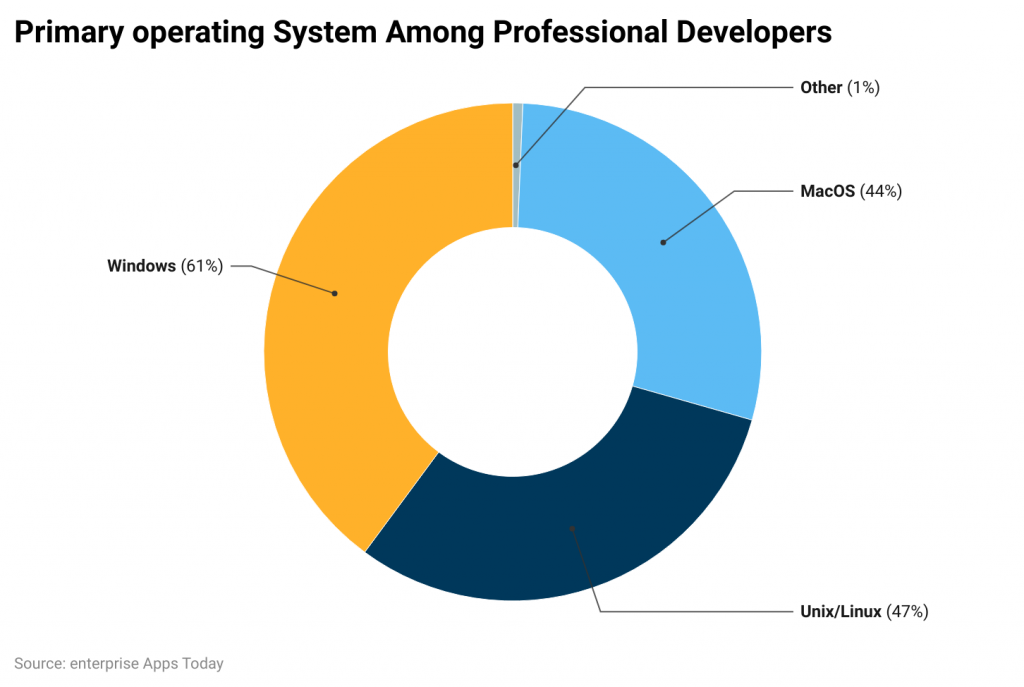
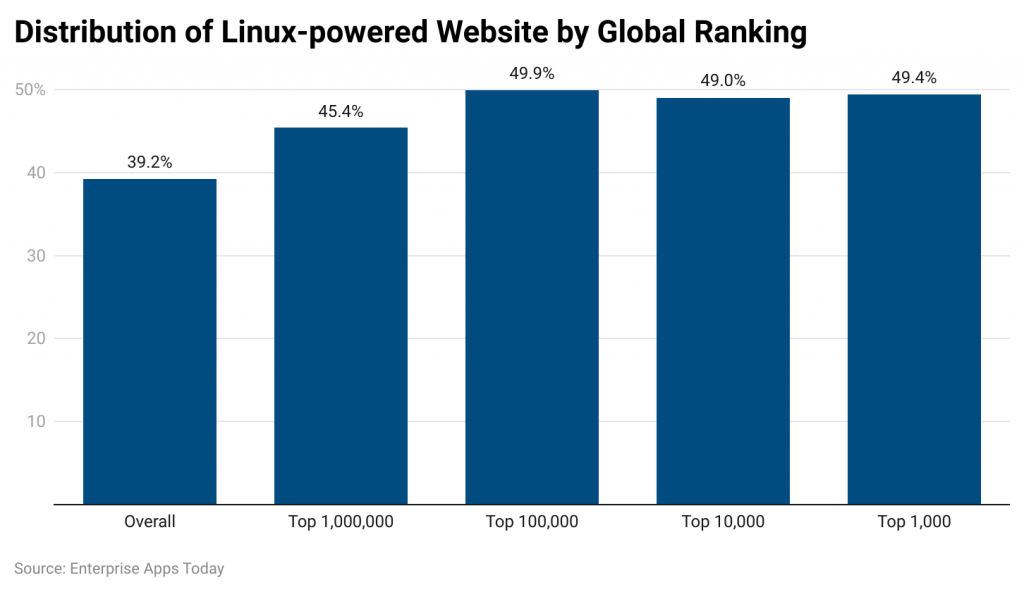
Women were 9.9% of all Linux kernel Git users.
This translates to roughly 330 female programmers, according to the most recent data. Women make up 6.8%, which is around 4,000 commits, of Linux users. OpenStack data show that women account for 11% or around 340 active developers. Their activity accounts for 9%. (Source: The Linux Foundation)
Linux boasts more than 27.8 million lines of code.
Linux statistics show that developers modified more than 11,859 lines of code to release kernel 5.14 while removing 285,485. It added over 817,700. Many think this is too much to be run on any smaller device. Contrary to what many believe, vendors rarely use all of the lines at once on all devices. It's one benefit of open-source, everyone can take what is needed. (Source: Linux, Linux Kernel Archive)
SpaceX used Linux-supported Linux systems to successfully complete 65 missions.
This includes the space mission which is famous, the Falcon 9. Linux users include NASA and ESA as well as other high-end organizations. (Source: OMG! Ubuntu!)
Nearly 90% of Hollywood special effects can be achieved using Linux.
Linux is used to create amazing special effects. It is used in more than 90% of Hollywood visual effects. Linux statistics show that Linux is more popular than other operating systems due to its flexibility, open-source code, and superior performance. (Source: Werts)
85% of smartphones are Linux-powered.
According to statistics, Android is the most popular operating system for smartphones, with 85% of them being Android-based. The Linux kernel is used in their creation. Android has a large market share today. The platform's dominance has been maintained by Linux Kernel Longterm-Support since its launch in Android 11. Linux user statistics confirm that. (Source: Hayden James)
Steam users are using Linux for 0.44%.
Gamers all around the world use Steam and it has thousands of games. Despite Windows's dominance among gamers, recent statistics show Valve Steam using Linux as an alternative. Around 4,000 Linux users using Linux in 2018, in terms of supported games. Linux Mint has 0.6% and Ubuntu is used by the majority of Linux users (0.18%). (Source: Statista, Blackdown)
Linux-based computer settings are allowed on Mozilla VPN in more than 30 different countries.
Linux statistics confirm that there are over 400 servers available worldwide. Users can get any content they want. Linux usage does not mean that you can't access it. It is possible to connect up to five devices running different operating systems (Windows, Mac, iOS, or Android). It is one of many best VPNs for Linux users should consider.
(Source: Mozilla)
Intel Technologies and Huawei Technologies rank among the top two contributors to Linux Kernel.
Intel employees contributed 12.6% towards Linux. There were 96.976 new lines. They also contributed 8% to the number of changesets. Huawei's contributions were the most amazing This company’s contributors made an addition of 8.9% (1.434 changesets), as well as modified lines (5.3% (41.049)). (Source: It's FOSS)
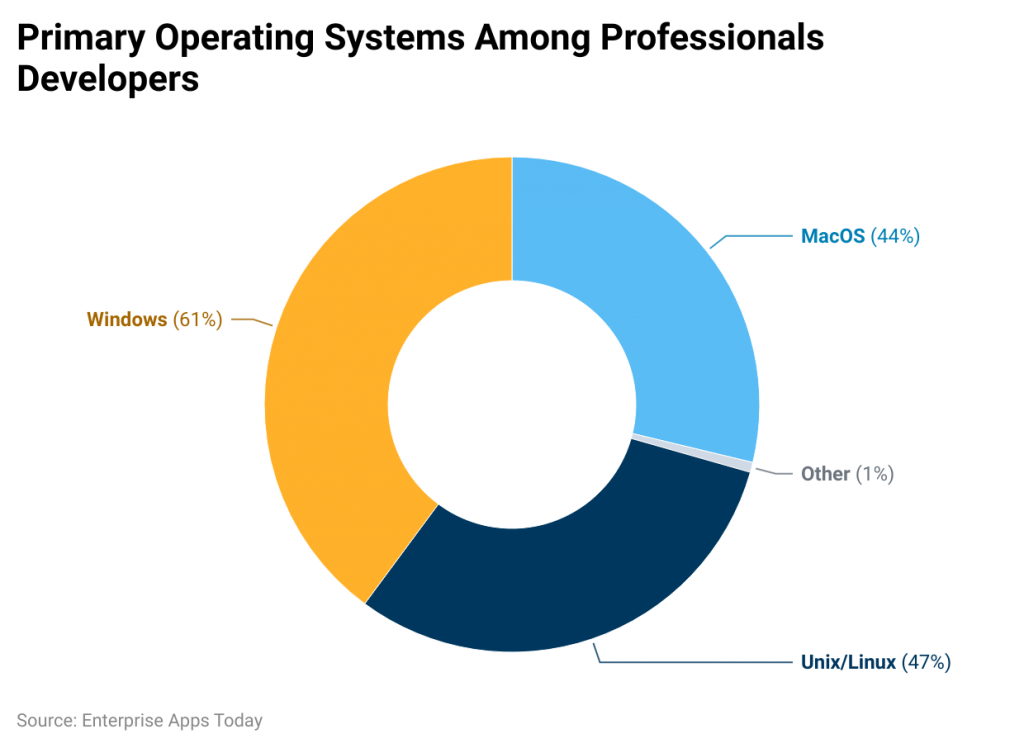 (Source: truelist.co)
(Source: truelist.co)
Linux has captured 47% of the primary operating system market among professional developers, while the majority of them prefer Windows (61%) followed by macOS (44%) and others (1%).
In 2027, the market of Linux worldwide will exceed $ 15.64 billion.
Statistics confirm that the Linux market share is growing at a rate of 19.2% due to an increasing number of servers and increased internet penetration. The key to market growth lies in the rapid expansion and use of data centers. Many branches of IT, healthcare, and manufacturing are moving to Linux which has an impact on market size. (Source: Fortune Business Insights)
Linux is the backbone of the top 500 most powerful supercomputers in the universe.
Linux has been dominant on the list for three years. In 2016, 498 supercomputers had Linux running as their operating system. All the others used Unix. Linux's open-source nature is a key reason why Linux is so widely adopted. This is because all supercomputers have specific purposes. Having an operating system that can adjust to those requirements is very important. (Source: Blackdown, ZDNet)
As of 2017, Linux users are around 90% of cloud infrastructure
According to the latest Linux usage statistics, 62% of embedded systems and 82% of smartphones run this OS. This code was created by more than 4,300 developers working for 500 of the largest companies in the world, including IBM. Red Hat. Intel. Red Hat.
(Source: Developer)
Linux is used to power 96.3% of the world's top web servers.
Twitter, Yahoo!, and eBay are only a few on which the Linus operating system is run. This speaks volumes about the popularity of Linux. According to server statistics, Linux is becoming increasingly important on the internet. In fact, 96.3% account for the servers which use Linux and it is one of the top one million. Windows (1.9%), and FreeBSD 1.8%) are the main players. (Source: ZDNet)
The Most Popular Linux Distribution
Today, over 600 Linux distros are active.
There are another 500 whose development is active. It has made a living system that is complex, is continuously updated, and expanded. Debian is the most used distribution. (Source: Tecmint)
Ubuntu accounts for 33.9% of Linux's market.
Ubuntu is the Linux operating system that runs more than a quarter of all websites. Debian is in second place at 16%. CentOS has a 9.3% share. RedHat Linux, Fedora Fedora, Fedora, and SuSe have lower shares (less than 1%). Their shares are 0.8% to 0.5%, 0.2% to 0.1% and respectively.
(Source: W3Techs)
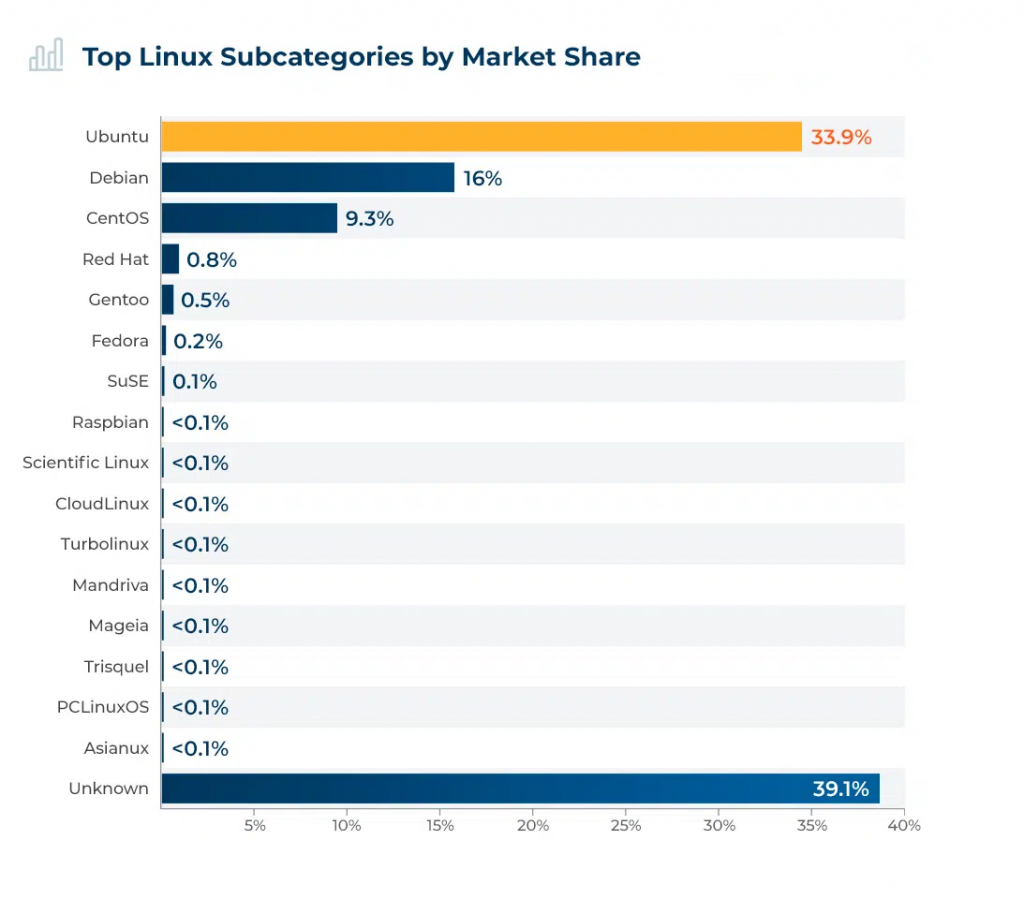
General Linux Statistics
- Linux has been installed in more than 85% of smartphones around the world.
- All of the world’s fastest supercomputers run on Linux OS.
- As of 2023, there are more than 600 active Linux distros.
- 47% of the professional developers are using Linux-based operating systems.
Linux Statistics By The Most Common OS on Smartphones
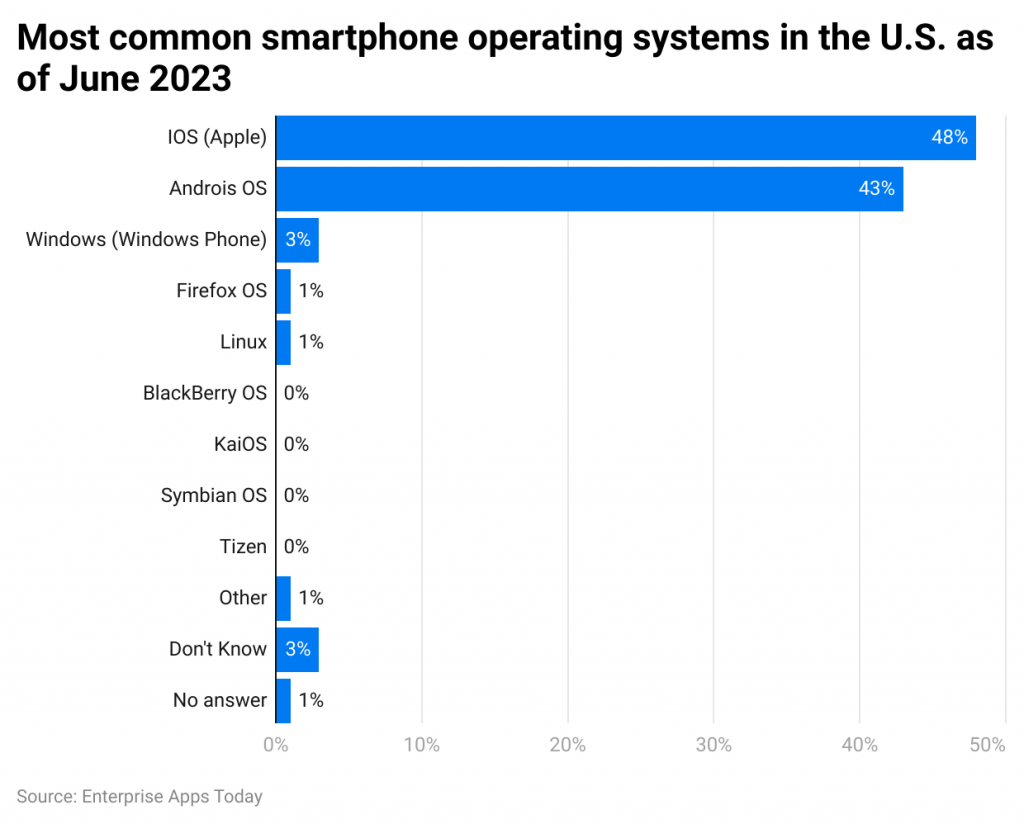 (Source: statista.com)
(Source: statista.com)
According to Linux Statistics by market share, in the United States of America, it has captured only 1% of smartphone operating systems, while the leading Operating Systems are iOS (48%) and Android OS (43%).
The US has almost two million Ubuntu websites.
Linux statistics show that 66% opted to use the OS for their data management. English is the main language of 59% of users followed by Spanish at 7%. Germany is the second-largest user of Ubuntu with 256.845 German websites. (Source: BuiltWith, Ubuntu)
50% of users saw AI and Machine Learning as the next big area of growth for this OS.
The survey was designed to provide insights to help Ubuntu make better decisions. It revealed that half of those surveyed expected Ubuntu to expand artificial intelligence and machine learning. Kubeflow was created to help AI and ML practitioners use the cloud. (Source: Ubuntu)
Red Hat's share of the global server operating system market is 33.9%
Linux server statistics revealed that this service had a 14.1% increase in subscriptions in 2018. In the same time frame, 51% of commercial server operations were carried out using paid subscriptions. Red Hat is a ‘progeny of Linux Kernel and has made more than $10 trillion. Microsoft has 47.8% and 18.3% respectively. (Source: Red Hat)
Over 1,000 developers have contributed to the Debian Project.
Debian's design is the basis of several Linux distros. Linux usage stats reveal that the flexibility of Debian's architecture makes it a solid base for the evolution and expansion of other distros. So both individuals and businesses can search for the best-suited distros or bundle Debian applications to meet their business objectives. (Source: Summer Code StorageCraft)
5.45% of Gentoo users are from heavy industry and engineering.
Gentoo offers a complete Linux distro. It has a san advanced system for managing packages — Portage. Gentoo hosts 16,101 websites. There are also 13,893 unique domains. According to Linux usage statistics, there are 16,101 websites that use Gentoo. Other industries that depend on the Linux distribution include electronics and tech (4.6%) and cars (3.97%), along with science and education (3.72%). (Source: SimilarTech, Linuxiac)
Conclusion
In conclusion, the Linux operating system continues to carve a significant niche across various sectors in 2024, demonstrating its versatility, reliability, and growing acceptance. Its impressive market share in web servers at 96.3% and the pivotal role in powering 85% of smartphones globally, via Android, underline Linux's foundational presence in the digital infrastructure. The steady increase in desktop users, with an annual growth of 800,000 to 900,000, further attests to its expanding user base.
The preference among developers, with nearly half favoring Linux for its flexibility and robustness, showcases its critical role in software development and innovation. Moreover, its dominance in the cloud infrastructure and IoT devices indicates a broader trend towards open-source solutions for complex technological needs.
The projected market size reaching $15.64 billion by 2027 reflects not only the economic impact but also the strategic importance of Linux in the future of technology. As such, Linux's trajectory in 2024 is marked by significant contributions to technology infrastructure, development, and innovation, making it a cornerstone of modern computing and digital services.
FAQ.
The Kernel, Hardware layer, System library, Shell, and system utility are some of the crucial components of the Linux OS’s structure.
Linux Operating system comes with many advantages but some of the best are stability, reliability, security, flexibility, open source nature, customizability, and cost-effectiveness.
Yes, the Linux operating system is free to use and can be downloaded, used, modified, and distributed without the need for any licensing fees. Some of the commercial Linux distributions require paid services.
Yes. While gaming on Linux you can use Proton or Steam for smooth functioning. However, not all games are Linux-friendly.

Barry is a lover of everything technology. Figuring out how the software works and creating content to shed more light on the value it offers users is his favorite pastime. When not evaluating apps or programs, he's busy trying out new healthy recipes, doing yoga, meditating, or taking nature walks with his little one.